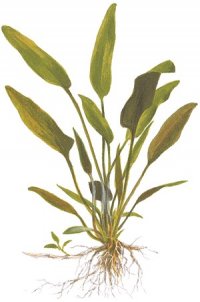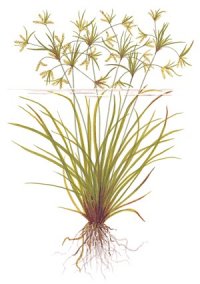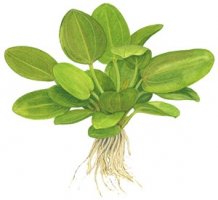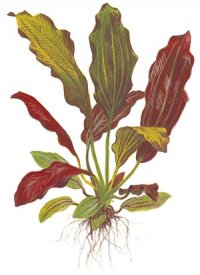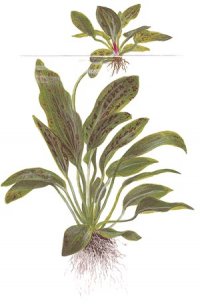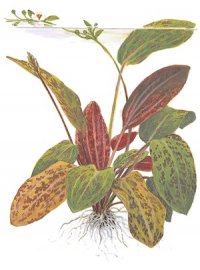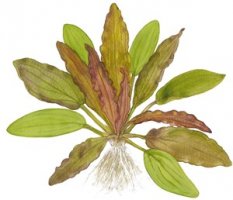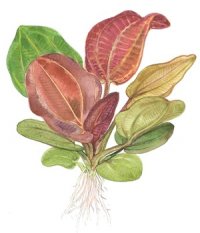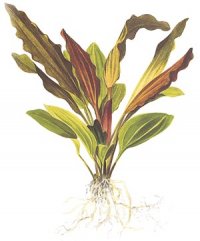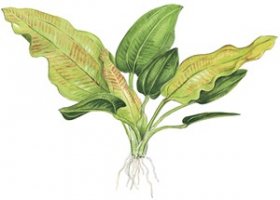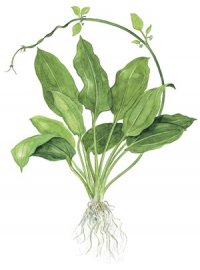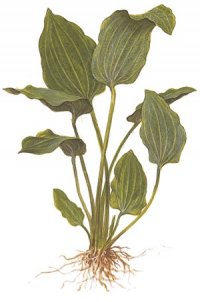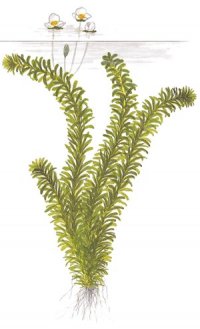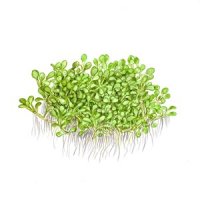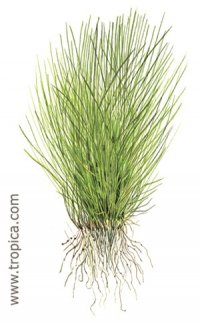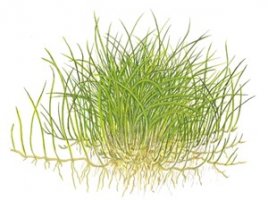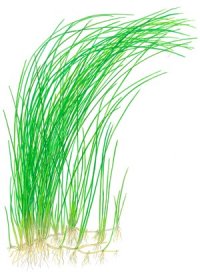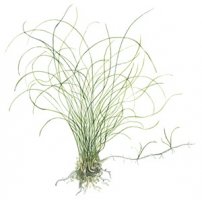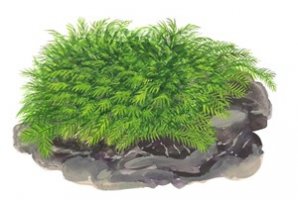-
You are viewing the forum as a Guest, please login (you can use your Facebook, Twitter, Google or Microsoft account to login) or register using this link: Log in or Sign Up
Aquatic Plants
All aquatic plant database
.
This Cryptocoryne from Sri Lanka used (mistakenly) to be called Cryptocoryne nevillii, but this is the name of a species that has never been used in aquariums. Like many other Cryptocorynes, not much happens the first month after planting. But then it starts to grow, and willingly produces plenty of runners which form a compact group. The plant becomes 7-20 cm tall, and each roset 7-15 cm wide.
Source: Tropica
Cyperus-species are widespread all over the tropics, but only a few of them are good underwater plants. Cyperus helferi from Thailand is the first Cyperus-species used in aquariums, 20-35 cm tall and a roset from 15-25 cm wide. It requires a relatively large amount of light, and CO2 addition is recommended to promote growth. In aquariums with good water flow the plant sways beautifully in the current.
Source: Tropica
Characteristics of the cultivar Echinodorus 'Aquartica' are its round, bright green leaves. Its compact (10-20 cm), low growth makes it suitable as a decorative solitary plant.
Slow growing and easy to care for, Echinodorus 'Aquartica' retains the refreshing green colour of its leaves in normal lighting and nutrient conditions in the aquarium. The plant is a cross between several different cultivated plants, including Echinodorus horemanii and several round-leafed Echinodorus species...
The cultivar Echinodorus ‘Barthii’ is a decorative and beautiful solitary plant for large aquariums. It becomes 25-50 cm tall and the whole rosette 20-30 cm wide.
The leaves change colour from dark-red in the youngest leaves to dark-green in the oldest. The colour develops well when the light intensity is high and there are sufficient micronutrients in the aquarium. A nutritious bottom and CO2 addition promote growth. This plant takes a lot of light from plants underneath, so it must be...
A beautiful, dark-green variety of Echinodorus 'Ozelot', 20-50 cm tall and a 20-40 cm wide rosette.
The dark spots form a bigger contrast on the light leaves. The leaf margin is fluted. A nutritious bottom promotes growth. It is an easy and highly recommended plant, which thrives in almost all conditions.
Source: Tropica
Echinodorus 'Ozelot' is a decorative hybrid between Echinodorus schluteri 'Leopard' and Echinodorus ‘Barthii’. 20-50 cm tall and a 20-40 cm wide rosette.
Naturally, it is the elliptical black spots on the red-brown leaves that have given this plant the name 'Ozelot'. The spots are darkest on the youngest leaves, and unlike many other spotted Echinodorus, 'Ozelot' retains its spots even at low light intensity.
It is an undemanding and good plant for beginners.
Source: Tropica
Echinodorus 'Red Diamond' appeared as a culture in the Ukraine, and is probably a cross between Echinodorus horemanni 'Red' and Echinodorus ‘Barthii’. The resultant hybrid is an attractive plant with ruby-red sword-shaped leaves, 15-25 cm long.
Unlike many of the other Echinodorus-species, Echinodorus 'Red Diamond' remains moderate in size (20-30 cm wide roset), so it is extremely well suited as a solitary plant, even in small aquariums. Increasing the nutrients in the substrate results in...
'Reni' is a well-known cultivar characterized by being easy to grow and amongst the smallest of the red Echinodorus, 15-40 cm tall and a roset from 15-25 wide.
The new leaves of the plant are reddish-brown to deep beetroot in colour. It can be used in small aquariums and is unpretentious. The plant requires a lot of light and nourishment for optimal colour development.
Source: Tropica
This beautiful plant is a hybrid between Echinodorus horemanii ‘Red’ and Echinodorus horizontalis.
It was first produced in 1986 by Hans Barth in Dessau and becomes 25-40 cm tall and a rosette from 15-25 cm wide. New underwater leaves are a beautiful pink, and initially the leaves have red-brown spots. A nutritious bottom promotes growth, but otherwise Echinodorus 'Rosé' is undemanding and thus an excellent plant for beginners.
Source: Tropica
A comparatively fast-growing Echinodorus from Mexico, suitable for large aquariums reaching 20-50 cm long leaves and a 15-30 cm wide roset. Easy and undemanding, excellent plant for beginners.
Its wavy, light green leaves are very decorative. Unlike other round-leafed varieties of the species, Echinodorus cordifolius fluitans is less likely to grow up over the water surface. If it grows large enough, it forms large leaves just under the surface instead.
Source: Tropica
Echinodorus bleheri from South America is undemanding and beautiful, and becomes 20-50 cm tall.
A nutritious bottom promotes growth, but the plant needs pruning to prevent it depriving plants underneath of light. Echinodorus bleheri does well even in poorly illuminated aquariums, as it grows towards the light.
It is a hardy and easy solitary plant for both beginners and the more experienced with quite large aquariums. It has been sold under the name "Paniculatus".
A bundle of stems or...
In marshy conditions, Echinodorus palaefolius var. latifolius from Brazil has round leaves with a horizontal leaf base. Under water the leaves are narrower and longer (from 20-40 cm, and a 20-40 cm wide roset).
In the aquarium it tends to grow out of the water. This can be prevented by removing the long leaves just before they reach the water surface. The next leaves will then become shorter and the plant will remain under water. In open aquariums the plant can be allowed to grow out of the...
The cosmopolitan Egeria densa is a good plant for beginners, and its rapid growth helps create a balance in the aquarium from the start. Stems grows fast to 40-100 cm and becomes 2-4 cm wide. Egeria helps preventing algae because it absorbs a great number of nutrients from the water.
The growth rate depends largely on the amount of light and nutrition available. Growth does not stop in unfavourable conditions, but the plant turns light in colour and the tendrils grow thin.
A bundle of...
The creeping growth of this stem-plant makes it highly attractive for creating carpets in the aquarium. The very small leaf size makes it an obvious choice for nano-tanks.
Its fresh green colour compliments wood, rocks and other plants extraordinary well and has made the plant increasingly popular.
The growth of Elatine hydropiper is quite similar to Hemianthus callitrichoides 'Cuba' and Glossostigma elatinoides but is considerably slower, making it easier to maintain.
Source: Tropica
Eleocharis acicularis is very common and thrives in almost all conditions in an aquarium. An open space without shading from other plants is still preferable.
To plant it in the aquarium, press the grid softly into the bottom layer till it is just covered. Roots will start colonizing the surroundings, creating a beautiful carpet of 6-15 cm height. If the carpet grows too tall, you may carefully cut it back to the preferred height.
Source: Tropica
Eleocharis acicularis 'mini' has even lower growth than the common Eleocharis parvula and was given to Tropica by Thomas Barr from USA. Plant the mini-version in small portions to cover a large area. In short time, a dense carpet will be obtained. Needs light to perform optimally, however, it is one of the most reliable species for creating a carpet – and a minimum of maintenance since the leaves remain short (3-5 cm). Suitable for nano-aquariums.
Source: Tropica
This American Eleocharis has a fresh grass green colour and grows to be 20-40cm high. It is basic and low maintenance. Each straw is only few millimeters thick and the plant maintains an open form of growth. It is suitable as a background plant, and can further be planted in front and in the centre of the aquarium, in transparent wads, in order to create depth and perspective. The plant spreads through runners, which occasionally have to be trimmed and maybe planted elsewhere.
Source: Tropica
A low-growing Eleocharis that forms runners close to the parent plant. It is prettiest planted in small bunches quite close to each other, which will gradually form a solid mass of plants. An ideal foreground plant, equally suited to large and small aquariums.
Source: Tropica
The genus Eriocaulon is usually adapted to soft water. Eriocaulon cinereum is more tolerant than most and will thrive in medium-hard water. Soft water will promote overall health.
This is a quite small, very narrow-leaved and almost cushion-growing plant, that demands good supply of light and CO2 to develop.
The plant usually flowers very willingly after planting in the aquarium and the numerous flower stems give a unique appearance.
Flowering easily drains the energy of the plant, but...
This featherlike Fissidens-moss with tight deep green down comes from North America. It grows relatively slow and requires much more light than other mosses. Suitable for attaching to wood pieces or rocks both vertically and horizontally in the aquarium.
Source: Tropica

